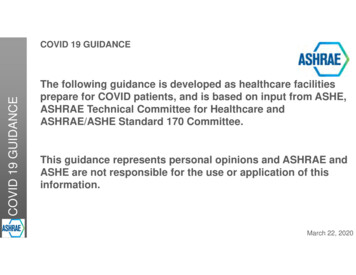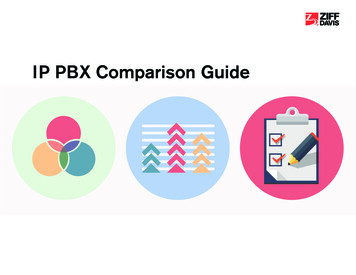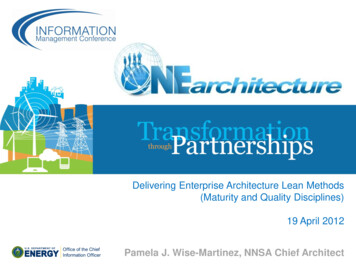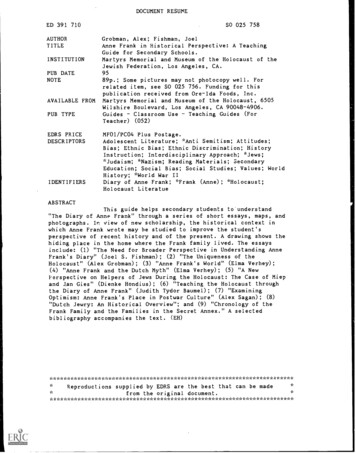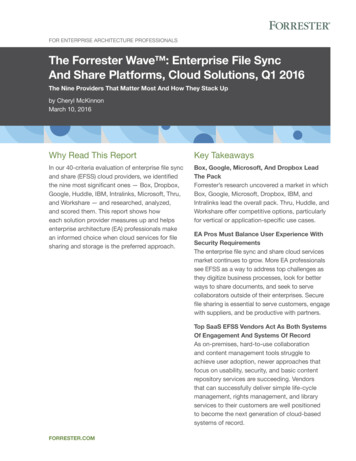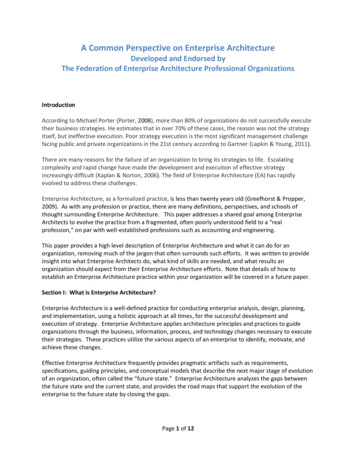
Transcription
A Common Perspective on Enterprise ArchitectureDeveloped and Endorsed byThe Federation of Enterprise Architecture Professional OrganizationsIntroductionAccording to Michael Porter (Porter, 2008), more than 80% of organizations do not successfully executetheir business strategies. He estimates that in over 70% of these cases, the reason was not the strategyitself, but ineffective execution. Poor strategy execution is the most significant management challengefacing public and private organizations in the 21st century according to Gartner (Lapkin & Young, 2011).There are many reasons for the failure of an organization to bring its strategies to life. Escalatingcomplexity and rapid change have made the development and execution of effective strategyincreasingly difficult (Kaplan & Norton, 2006). The field of Enterprise Architecture (EA) has rapidlyevolved to address these challenges.Enterprise Architecture, as a formalized practice, is less than twenty years old (Greefhorst & Propper,2009). As with any profession or practice, there are many definitions, perspectives, and schools ofthought surrounding Enterprise Architecture. This paper addresses a shared goal among EnterpriseArchitects to evolve the practice from a fragmented, often poorly understood field to a “realprofession,” on par with well-established professions such as accounting and engineering.This paper provides a high level description of Enterprise Architecture and what it can do for anorganization, removing much of the jargon that often surrounds such efforts. It was written to provideinsight into what Enterprise Architects do, what kind of skills are needed, and what results anorganization should expect from their Enterprise Architecture efforts. Note that details of how toestablish an Enterprise Architecture practice within your organization will be covered in a future paper.Section I: What is Enterprise Architecture?Enterprise Architecture is a well-defined practice for conducting enterprise analysis, design, planning,and implementation, using a holistic approach at all times, for the successful development andexecution of strategy. Enterprise Architecture applies architecture principles and practices to guideorganizations through the business, information, process, and technology changes necessary to executetheir strategies. These practices utilize the various aspects of an enterprise to identify, motivate, andachieve these changes.Effective Enterprise Architecture frequently provides pragmatic artifacts such as requirements,specifications, guiding principles, and conceptual models that describe the next major stage of evolutionof an organization, often called the “future state.” Enterprise Architecture analyzes the gaps betweenthe future state and the current state, and provides the road maps that support the evolution of theenterprise to the future state by closing the gaps.Page 1 of 12
Enterprise Architecture uniquely fosters dialog to create shared meaning and to deliver shared goals.The primary purpose of describing the architecture of an enterprise is to provide the holistic informationand insights to effectively frame the opportunities of the organization and make better informeddecisions. With Enterprise Architecture, organization leaders can more readily improve theeffectiveness, efficiency, and responsiveness of their enterprise.Organizations undertake Enterprise Architecture (EA) for a variety of reasons. Leaders want theirorganizations to better perform and better satisfy their stakeholders by doing things differently, andthey expect the EA practice to enable such change. Because enterprise architects consider commonstrategic goals and strong integration between business strategy, enterprise program management,portfolio management and governance functions, they are able to bridge the gap from strategy toimplementation in an organization.Importantly, the work done by an Enterprise Architect is not specific to any one kind of organization.Enterprise Architecture provides benefits to government, commercial, military, non-profit, andcomposite organizations. In addition, EA can apply its methods at different organizational levels -- fromdepartments and divisions up through companies and more complex organizations (such as multinationals and national governments). As a result, EA considers the relationships and value streams thatoccur within any arbitrary “boundary” as well as outside that boundary.In this respect, Enterprise Architecture engenders a practice that not only requires awareness of theorganization’s “external” environment, but actively leverages that knowledge to identify improvements”internally.” EA is a highly versatile and useful mechanism for fitting an organization into itsenvironment in the most effective and purposeful manner possible.Some argue that the practice of Enterprise Architecture is not really a new discipline but rather acollection of older, existing practices. In many respects this is true. Just as many of today’s establishedprofessions evolved from a collection of practices, Enterprise Architecture is in the process ofconsolidating, enhancing, and adding structure to many practices that have been performed to differentdegrees in organizations for decades. As the Enterprise Architecture practice evolves into a moreformalized profession, the link that EA could (and many would say should) have with enterprise strategicplanning is beginning to be better understood in many organizations today.One frequently used analogy is the comparison of an Enterprise Architect to an Urban Planner. As thefollowing figure implies, the building architect is analogous to the solution architect in that both aretypically concerned with the construction of a single entity or system. The Urban Planner is somewhatanalogous to the Enterprise Architect and Enterprise Architecture team in that the urban planning teamneeds to understand what the building architect (solution architect) does, but also needs to understanda wide range of topics that the building architect doesn’t need to deal with – things like the vision ofhow the urban area should evolve, the safety and livability of the urban area, urban infrastructurecapacity and modernity, urban systems interactions and integration, and many other areas.In many respects, Enterprise Architecture professionals are the urban planners for the enterprise.Page 2 of 12
The Evolving View of Enterprise ArchitectureEnterprise Architecture as a practice meets an emerging need in our rapidly changing world. Any area ofan organization that has to deal with rapid change and a complex set of challenges can leverageEnterprise Architecture. This ability to cope with complexity amidst change is driving the evolution ofEA.Enterprise Architecture rose to prominence when organizations began to cope with rapid changes intechnology and diversity in operating models. The business needs around systems integration, the shiftfrom mainframe computing, and the emergence of personal computing were sufficiently complex topush organizations to find systematic solutions to the problems of complex change.The scope of Enterprise Architecture in some organizations today is maturing. All kinds of organizations,from commercial businesses to government agencies, find themselves needing to cope with complexchanges in order to quickly react. The ideas used by Enterprise Architects are not technology specific,and these expert change agents have found their skills and methods to be in demand well beyondtechnology settings. Enterprise Architecture provides a wide array of services such as helping withbroad changes in business and organizational models, improving partner relationships, implementingstrategies, and addressing changing stakeholder demands. While many of the existing methods andtools were developed with technology change in mind, these tools are rapidly evolving to address suchnon-technical concerns.The individual models produced in the EA process are arranged in a logical manner, and this provides anever-increasing degree of detail about the enterprise, generally including (but not limited to): Enterprise goals and objectivesEnterprise capabilities, values streams, and informationEnterprise portfolio of business solutionsEnterprise technologies and resourcesThe term “Enterprise Architecture” has various uses. In some cases, EA practices may focus on theoutputs ("the noun") rather than the practice of EA. This paper primarily uses the term “EnterpriseArchitecture” to refer to a practice (“the verb”) rather than outputs or deliverable artifacts. Practitionersfind that focusing on Enterprise Architecture as a continuous practice allows EA guidance to evolve inPage 3 of 12
response to the desire for particular business outcomes. A continuous process provides clarity for theongoing transformation of an enterprise.Figure 2: The General Process of Enterprise ArchitecturePage 4 of 12
Ongoing ChangeOne element worth noting is the potential for Enterprise Architecture to be a mechanism fortransformational change and adaptation in an organization. The environment “outside” an organizationis always changing. Responding to that change results in a steady stream of new products, newconsumers, new partners, and new ways to do business. Organizations must “dance to the new music”or risk becoming inefficient or uncompetitive. Enterprise Architecture is quickly becoming an essentialfeature of companies and organizations that evolve to meet changing needs.Adaptation, by itself, is not the goal: nimble organizations are. But organizations are simply groups ofpeople, and helping people to adapt requires making changes. Sometimes, small changes, like a newproduct or a feature in a product, are sufficient. Sometimes, the company itself has to change. Forexample, an organization may need to outsource (or insource) a part of the business to staycompetitive. Perhaps it needs to open up sales in new markets, or distribute production amongsuppliers in a new way, or merge with a former competitor or supplier. Nearly every large organizationhas dealt with these changes, often many times.Changing an enterprise is not just the job of Enterprise Architecture, and in fact most organizations“execute change” without Enterprise Architecture involved. Those that are beginning to use EA,however, have a distinct advantage. EA provides a repeatable set of techniques that allow anorganization to design their own future, plan for its evolution, and successfully implement thesechanges. The result is an organization that is simpler to operate, more nimble in the marketplace, andquicker to seize opportunities.With Enterprise Architecture involved, organizational changes are completed more quickly, whileprotecting and enhancing shareholder value. On the opposite end of the spectrum, organizations thatchange without EA often become frail and cumbersome over time. These organizational changes canbe dramatic, with large-scale reorganization of people, systems, and accountabilities. They can also begradual and steady, involving hundreds of small, non-disruptive steps. Regardless of the approachtaken, change is often complex and error-prone. Enterprise Architecture, through continuousevaluation and adaptation of the enterprise, reduces the cost of change and improves the chances forsuccess.Enterprise Architects, used correctly, are able to employ a wide array of techniques to bring aboutchanges, both dramatic and incremental. These techniques are often discussed in the context of four“types” of architecture that are all included within the scope of EA. Business architecture is used todesign competitive structures and processes, leverage existing strengths, and identify potentialinvestment opportunities that advance the business’s objectives and drive innovation. Informationarchitecture accelerates the availability, consistency, and quality of rapidly growing volumes ofinformation. Applications architecture describes the behavior, structure and interrelationships of theapplications used in an organization and their interactions with information, business processes, and thepeople who use them. Technology architecture brings new and existing technologies together in a richyet consistent mosaic to ensure security, availability, and reliability. A fifth “type” of architecture, oftencalled solution architecture, is composed of all four of the above types, but operates at a tactical levelbelow enterprise architecture, focusing on the scope and span of a selected business problem. For aPage 5 of 12
given organization, the EA function may partition their scope differently to accommodate the widevariety of stakeholder concerns.Transformational ChangeRegardless of whether an organization undergoes a large and dramatic reorganization or a steady seriesof non-disruptive tweaks, Enterprise Architecture has the opportunity to contribute by finding andexpressing transformational opportunities. These are opportunities to transform beyond the typicalareas of responsibility and alignment by addressing the challenges of new business models. For suchlarger changes, the planning for transformation is continuous, but the transformation itself may occur ina short time frame.Transformational change, when conducted under the rigorous lens of Enterprise Architecture, uses amethodical approach to understand the existing enterprise and to create measurable and clearly alignedchange programs. This methodology reduces risk and speeds up the transformation process.Transformational changes typically include large mergers or acquisitions, rapid adoption of new businessmodels, or the shift from one overarching operating model to another.With transformational change being demanded by the ever-increasing speed of business, EnterpriseArchitecture has had to change as well. While the Enterprise Architecture practice in the past hadfocused primarily on the technological aspects of change, the practice is quickly evolving to use arigorous business architecture approach to address the organizational and motivational aspects ofchange as well.Enterprise Architects, in this new mold, are evolving to leverage cross-functional business acumen aswell as cross “domain” understanding within both business and technology. TransformationalEnterprise Architecture coordinates enterprise-wide efforts that allow the benefits of transformation tobe realized as quickly as possible without shying away from the difficult work of process improvement,clarification of decision structures, and systems integration.Section II: What Differentiates the Enterprise Architecture Practice from Other Functions andPractices in an Organization?Creating an effective business strategy is difficult. It is also difficult to make the needed changes to anorganization to bring that strategy to life. Enterprise Architecture requires a specific mix of skills andabilities, combining the mindset of an engineer with the business awareness of an operational leader,and adding in the innovative creativity of an entrepreneur. Enterprise Architecture gives powerful toolsand methods to these unique individuals, allowing them to do more than offer tiny improvements oreven to optimize investments.Enterprise Architecture is both an art and a science. Enterprise Architects guide stakeholders within anorganization to look across systems and silos to envision change with far reaching enterpriseimplications. These talented practitioners help leaders to consider alternative ways in which thatchange can happen, and they are able to dive to the deepest details needed to ensure that business andprocess changes are properly constrained and executed. From the highest levels of change (changes inthe business models and value streams) to the most detailed minutiae like the use of specific tools orPage 6 of 12
technologies, the Enterprise Architecture process offers an effective and needed complement tostrategic planning by doing more than describing a series of projects. Enterprise Architects arecomfortable with uncertainty and bring a socially-aware approach to addressing difficult and ill-definedcomplexities.To understand what is meant by this statement, let’s go back to the urban planning analogy. The mayorand city council (the C-level executives) work with a strategic planning group to develop a strategic planfor the city. The urban planner then works closely with elected officials, civic leaders, civil engineers,building architects, and community groups to help develop and implement the city’s strategic plan overtime. Without the urban planning team as the bridge between the strategic vision and the people whoimplement aspects of the strategic plan (building architects, road and infrastructure architects,engineers, etc.), there would be little or no coordination between the people at the implementationlevel and no city-wide analysis, design, and planning to ensure an effective and efficient implementationof the city strategic plan.An Enterprise Architecture practice collaborates with many inter-connected disciplines includingperformance engineering and management, process engineering and management, IT and enterpriseportfolio management, governance and compliance, IT strategic planning, risk analysis, informationmanagement, metadata management, and a wide variety of technical disciplines as well asorganizational disciplines such as organizational development, transformation, innovation, and learning.Increasingly, many practitioners have stressed the important relationship of Enterprise Architecture withemerging holistic design practices such as design thinking, systems thinking, and user experience design.Section III: What Value Does Enterprise Architecture Bring to an Organization?An EA practice delivers business value by producing several results, including but not limited to: An articulation of the strategic requirements of the enterpriseModels of the future state, which illustrate what the enterprise should look like across all EAviewpoints in support of the business strategyA road map of the change initiatives required to reach that future stateThe requirements, principles, standards and guidelines that will steer the implementation ofchange initiativesWhile these outputs are often the visible “things” created by Enterprise Architects, they are created inservice of specific outcomes. Enterprise Architecture exists to help deliver an array of outcomesincluding, but not limited to: Improvements to the effectiveness, efficiency, and agility of the enterpriseInnovations in the structure of an organizationImprovements in the capability of continuous organizational innovation and change competencyThe rational centralization or federation of business processesImprovements to the quality and timeliness of business informationClarification and articulation of business rulesAlignment of spending so that money spent on business initiatives and systems actually deliverson the strategic intentPage 7 of 12
There are many different ways to use this information to improve the functioning of an organization.One common approach is to maintain a description of the enterprise that represents a "target" or"future state" goal. A set of intermediate steps is created that illustrates the process of changing fromthe present situation to the target future state. These intermediate steps are called "transitionalarchitectures" by some in the field.The value of Enterprise Architecture is measured in many ways. In most cases, the notion of “value”includes measures that are non-financial as well as financial measures. When discussing the value ofstrategically oriented functions like strategic planning or urban planning, a longer-term valueunderstanding is essential. Strategic planning alone does not produce a directly measurable return oninvestment (ROI). However, the successful execution of the strategic plan in the form of projects thatare well aligned with the strategic plan produces benefits on many levels to the enterprise.A formal Enterprise Architecture practice or group can provide for the efficient, effective, and consistentanalysis, planning, design, and implementation of strategic needs. The lack of a formal EA practiceimplies that the needed bridge between strategy and execution either does not exist at all or exists infragmented pieces in the organization.The Enterprise Architecture practice can have a unique vantage point across an enterprise. That insightand viewpoint is necessary to help identify and develop areas of possible innovation.More Than a FadThe trends and needs of business are constantly changing. Just a few years ago, organizations werefocused on agility and manageability as core issues. After that, the focus shifted to security. The currentmanagement trend is around innovation. Regardless of which one of these trends may be motivatingchange in an organization or what trends may emerge in the future, Enterprise Architecture is a keyelement enabling rapid and rational changes in businesses, government, non-profit organizations, andany other kind of human enterprise.ConclusionEnterprise Architecture is a useful and unique practice. It is quickly becoming a core competency fororganizations dealing with the complexity of overwhelming change. The continuous and ongoingapplication of Enterprise Architecture solves one of the most difficult challenges of modern enterprises:making sure that senior leaders can bring about the changes needed to deliver the strategies they havepromised to their stakeholders. The unique blend of skills demanded by Enterprise Architecture,including business, information, and technology competencies, and the carefully engineered and provenmethods they employ allow Enterprise Architects to address the obstacles to strategic change.Commercial, government, and non-profit organizations throughout the world are successfully usingEnterprise Architecture to adapt to the ever-increasing demand for change.Future DirectionsThe seventeen professional organizations of the Federation of Enterprise Architecture ProfessionalOrganizations (FEAPO) authored and developed this paper. FEAPO, a worldwide association ofprofessional organizations, was established in 2011 to provide a forum to standardize, professionalize,and otherwise advance the discipline of Enterprise Architecture.Page 8 of 12
This paper is the first of a planned series of papers on the Enterprise Architecture profession that willprogressively dive deeper into various aspects of this evolving field. The initial papers will explorecurrent and emerging issues and trends surrounding many of the topics highlighted in this paper. Formore information on FEAPO and how to become involved in these and other initiatives, please visit:http://www.feapo.org/.Page 9 of 12
AcknowledgementsFEAPO would like to recognize and thank Dr. Brian Cameron, FEAPO Founding President, and Nick Malik,Center for the Advancement of the EA Profession (CAEAP), for their efforts in organizing and drafting theinitial survey, assisting with the data collection, and drafting the initial versions of this paper. Withouttheir efforts, this paper would not be where it is today.FEAPO would also like to acknowledge and thank the representatives of the FEAPO memberorganizations for their contributions to this paper: Trekker Armstrong*, Canadian Information Processing SocietyKevin Brennan, International Institute of Business Analysis (IIBA)Andy Chen*, IEEE Computer SocietyDavid Chesebrough*, The Association for Enterprise InformationSteve Delahunty, The Network Professional AssociationCharles Dickerson, International Council on Systems EngineeringMichael Gladstone, International Institute of Business Analysis (IIBA)Mark Goetsch*, Center for the Advancement of the EA ProfessionAndrew Guitarte*, Business Architecture SocietyBob Hart, Australian Computer SocietyDeborah Henderson, DAMA International and DAMA International Education & ResearchFoundationIngrid Batiste Hunt*, DAMA International and DAMA International Education & ResearchFoundationStephen Ibaraki*, The Global IT Community Association (GITCA) and The InternationalFederation for Information Processing International Professional Practice PartnershipGraham Jones, The Global IT Community Association (GITCA)Mark Lane*, Center for the Advancement of the EA ProfessionMarc Lankhorst, Netherlands Architecture ForumRichard Martin, International Council on Systems EngineeringRobert McIlree, Center for the Advancement of the EA ProfessionMaureen McVey , International Institute of Business Analysis (IIBA)Daniel St. George, Institute of Information Technology Professionals New ZealandPaulo Rocha, Institute of Information Technology Professionals New ZealandMike Rosen, The Business Architecture GuildJulian Sammy, International Institute of Business Analysis (IIBA)Eric Sweden*, The National Association of State Chief Information Officers (NASCIO)Barry Sellers*, The Network Professional AssociationSanjay Shirude, DAMA InternationalRaymond Slot, Netherlands Architecture ForumWilliam Ulrich*, The Business Architecture GuildGina Van Dalen, Canadian Information Processing SocietyCharlene (Chuck) Walrad*, IEEE Computer SocietyJeff Walk, Center for the Advancement of the EA ProfessionRalph Whittle, Business Architecture SocietyPage 10 of 12
Peter Wilson*, The Enterprise Architecture Shared Interest Group from the Industry AdvisoryCouncil*FEAPO Founding membersFEAPO would also like to recognize and thank the group of external reviewers that graciously offered toprovide additional input into this paper: Bill Cason, TrouxRoss Eisenberg, The Corporate Executive BoardLeonard Fehskens, The Open GroupBen Geller, TrouxTim DeGennaro, Forrester ResearchChristiane Groth, The Corporate Executive BoardUlrich Kalex, AlfabetZbigniew (Joe) Kielczewski, CiscoDr. James Lapalme, Numerix Research LaboratoryNavin Maganti, Confiance GroupEd Moshinsky, Lockheed Martin CorporationKurt Nelson, Boeing CorporationDr. Carlo J. Ninassi, Pennsylvania State UniversityRoberto Sehringer, Johnson & JohnsonJeff Scott, AccelareRolf Siegers, Raytheon CorporationDr. Jeffrey L. Spearly, Pennsylvania State UniversityBob Szelistowski, Raytheon CorporationMaria W. Taylor, Pennsylvania State UniversityMark Thomas, Progressive InsuranceDavid Twadell, BCS, The Chartered Institute for ITDr. Albert A. Vicere, Pennsylvania State UniversityMichael Warner, EMCPage 11 of 12
ReferencesGreefhorst, Danny, & Propper, Erik. (2009). Enterprise Engineering: Architecture Principles - TheCornerstones of Enteprise Architecture. In Jan L.G. Dietz, Erik Proper & José Tribolet (Eds.),Architecture Principles the Cornerstones of Enterprise Architecture (Vol. 4th). Heidelberg:Springer.Kaplan, Robert S., & Norton, David P. (2006). Alignment Using the Balanced Scorecard to CreateCorporate Synergies. Harvard Business School Publishing Corporation.Lapkin, Anne, & Young, Colleen M. (2011). The Management Nexus: Closing the Gap Between Strategyand Execution. Gartner.Porter, M.E. (2008). The Five Competitive Forces That Shape Strategy. Harvard Business Review, January2008, pp. 79–93.Page 12 of 12
Enterprise Architecture is a well-defined practice for conducting enterprise analysis, design, planning, and implementation, using a holistic approach at all times, for the successful development and execution of strategy. Enterprise Architecture applies architecture principles and practices to guide organizations through the business .


